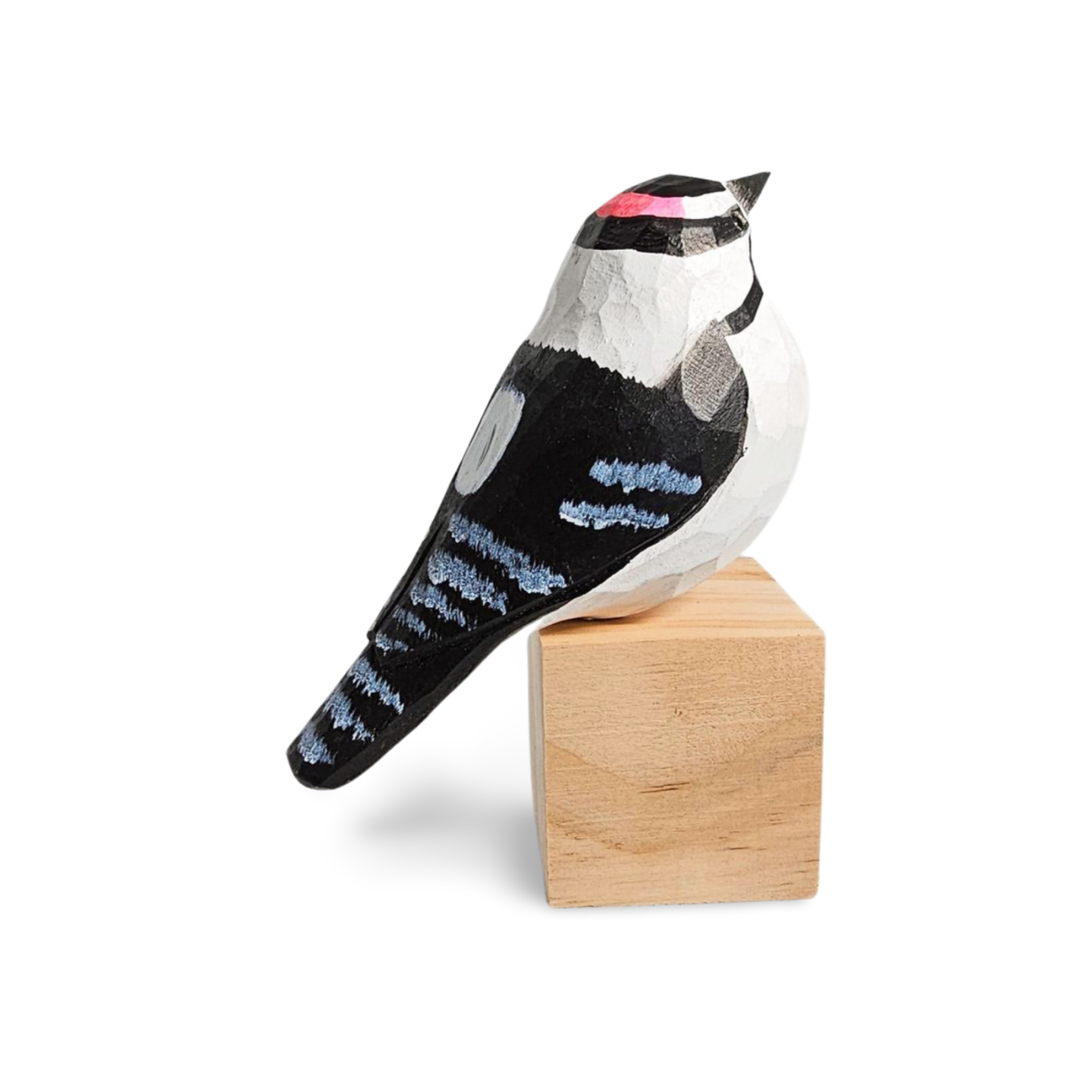
The Downy Woodpecker: Nature's Tiny Drummer
Share
 Meet the Downy Woodpecker
Meet the Downy Woodpecker
The Downy Woodpecker (Picoides pubescens) is the smallest woodpecker species found in North America, yet it is one of the most widely recognized and beloved. With its striking black and white plumage, distinctive red patch on the males, and characteristic drumming sound, the Downy Woodpecker is a familiar sight in woodlands, parks, and even backyard feeders. In this blog, we’ll explore the fascinating characteristics, behavior, and habitat of the Downy Woodpecker, as well as tips for attracting this charming bird to your yard.
Physical Characteristics: A Small but Mighty Bird The Downy Woodpecker is easily identified by its black and white coloration. The bird’s back is primarily black with a white stripe down the center, while its wings are patterned with black and white spots. The underparts are white, and the face is marked with black and white stripes. Males have a small red patch on the back of their heads, which distinguishes them from females.
-
Size and Build: The Downy Woodpecker is a small bird, measuring about 6 to 7 inches in length with a wingspan of around 10 to 12 inches. Despite its small size, the Downy Woodpecker is a skilled and powerful forager, capable of pecking into tree bark to find insects.
-
Beak: The Downy Woodpecker’s beak is short and straight, adapted for tapping and drumming on trees. It’s important to note that the Downy Woodpecker’s beak is relatively shorter in comparison to its larger relative, the Hairy Woodpecker, which can help with identification.
Habitat and Distribution The Downy Woodpecker is a highly adaptable bird, found across a wide range of habitats in North America. It can be spotted in deciduous forests, mixed woodlands, orchards, and urban areas.
-
Range: This woodpecker’s range extends across most of the United States and Canada, from the southernmost parts of Canada to the northern regions of the U.S. During the winter, the Downy Woodpecker’s range may expand slightly as they search for food.
-
Preferred Habitat: Downy Woodpeckers prefer areas with a mix of trees, particularly those that have dead or decaying wood, which is rich in insects. They are also commonly seen in suburban and urban areas, where they can be found visiting bird feeders or exploring tree trunks in parks and gardens.

Behavior and Diet: The Drumming of a Downy The Downy Woodpecker is known for its distinctive drumming behavior, which it uses to communicate and establish territory. This drumming is not only a means of communication but also a method of foraging for insects hidden within tree bark.
-
Feeding Habits: The Downy Woodpecker’s diet consists primarily of insects, including beetles, ants, and caterpillars. They use their sharp beaks to peck at tree bark, prying it away to access the insects beneath. In addition to insects, Downy Woodpeckers also eat seeds, berries, and sap, especially during the winter months when insects are less abundant.
-
Drumming: The rapid drumming sound made by Downy Woodpeckers is a familiar sound in many forests and backyards. This drumming is used to attract mates and establish territory, as well as to communicate with other woodpeckers. The sound is produced by the bird’s beak rapidly striking a tree trunk or branch, and it can be heard from quite a distance.
Attracting Downy Woodpeckers to Your Yard If you want to attract Downy Woodpeckers to your yard, there are a few simple steps you can take:
-
Provide a Variety of Food Sources:
- Feeders: Downy Woodpeckers are attracted to suet feeders, which provide them with a high-energy food source, especially during the winter. You can also offer sunflower seeds, peanuts, and mealworms.
- Natural Food Sources: Maintaining a yard with trees, especially those with dead or decaying wood, can provide natural foraging opportunities for Downy Woodpeckers. Planting berry-producing shrubs can also attract these birds.
-
Install Nesting Boxes:
- Nesting Sites: Downy Woodpeckers will use nest boxes, especially those that mimic natural cavities found in trees. Place the boxes in a quiet area of your yard, away from heavy foot traffic, to encourage nesting.
-
Maintain a Natural Habitat:
- Tree Cover: Providing plenty of trees and shrubs will create a welcoming environment for Downy Woodpeckers. Leaving some dead trees or branches can also help, as these provide natural nesting and foraging sites.
Conservation Status The Downy Woodpecker is currently listed as a species of least concern by the IUCN, meaning it is not at immediate risk of extinction. However, like all wildlife, Downy Woodpeckers benefit from conservation efforts that preserve their natural habitats. Protecting woodlands, reducing pesticide use, and maintaining natural foraging and nesting sites are important steps in ensuring that these birds continue to thrive.
Conclusion: A Delightful Visitor The Downy Woodpecker is a delightful bird that brings joy to birdwatchers and nature lovers alike. Its distinctive drumming, striking appearance, and friendly presence make it a welcome visitor to any backyard. By providing the right habitat and food sources, you can enjoy the company of these charming birds year-round, while also contributing to their conservation.







